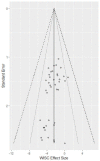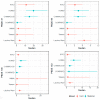Effects of Polybrominated Diphenyl Ethers on Child Cognitive, Behavioral, and Motor Development
- PMID: 30072620
- PMCID: PMC6121413
- DOI: 10.3390/ijerph15081636
Effects of Polybrominated Diphenyl Ethers on Child Cognitive, Behavioral, and Motor Development
Abstract
Polybrominated Diphenyl Ether (PBDE) flame retardants are environmental chemicals that cross the placenta during pregnancy and have shown evidence of neurotoxicity. As the in utero period is a sensitive developmental window, such exposure may result in adverse childhood outcomes. Associations between in utero PBDE exposure and neurodevelopment are found in animal models and increasingly in human population studies. Here, we review the epidemiological evidence of the association between prenatal exposure to PBDEs and motor, cognitive, and behavioral development in infants and children. Published work suggests a negative association between PBDE concentrations and neurodevelopment despite varying PBDE congeners measured, bio-specimen matrix used, timing of the biological sampling, geographic location of study population, specific developmental tests used, age of children at time of testing, and statistical methodologies. This review includes 16 published studies that measured PBDE exposure in maternal blood during pregnancy or in cord blood at delivery and performed validated motor, cognitive, and/or behavioral testing at one or more time during childhood. We evaluate possible mediation through PBDE-induced perturbations in thyroid function and effect measure modification by child sex. While the majority of studies support an adverse association between PBDEs and neurodevelopment, additional research is required to understand the mechanism of action, possibly through the perturbations in thyroid function either in the pregnant woman or in the child, and the role of biologically relevant effect modifiers such as sex.
Keywords: child behavior; child cognition; child motor development; child neurodevelopment; polybrominated diphenyl ethers (PBDEs); review.
Conflict of interest statement
The authors declare no conflict of interest.
Figures







References
-
- Hood E. Endocrine disruption and flame-retardant chemicals: PBDE-99 effects on rat sexual development. Environ. Health Perspect. 2006;114:A112–A113. doi: 10.1289/ehp.114-a112b. - DOI
-
- Lilienthal H., Hack A., Roth-Härer A., Grande S.W., Talsness C.E. Effects of developmental exposure to 2,2′,4,4′,5-pentabromodiphenyl ether (PBDE-99) on sex steroids, sexual development, and sexually dimorphic behavior in rats. Environ. Health Perspect. 2006;114:194–201. doi: 10.1289/ehp.8391. - DOI - PMC - PubMed
-
- Schreiber T., Gassmann K., Götz C., Hübenthal U., Moors M., Krause G., Merk H.F., Nguyen N.-H., Scanlan T.S., Abel J. Polybrominated diphenyl ethers induce developmental neurotoxicity in a human in vitro model: Evidence for endocrine disruption. Environ. Health Perspect. 2010;118:572–578. doi: 10.1289/ehp.0901435. - DOI - PMC - PubMed
-
- Lam J., Lanphear B.P., Bellinger D., Axelrad D.A., McPartland J., Sutton P., Davidson L., Daniels N., Sen S., Woodruff T.J. Developmental PBDE exposure and IQ/ADHD in childhood: A systematic review and meta-analysis. Environ. Health Perspect. 2017;125:086001. doi: 10.1289/EHP1632. - DOI - PMC - PubMed
Publication types
MeSH terms
Substances
Grants and funding
LinkOut - more resources
Full Text Sources
Other Literature Sources
Research Materials

